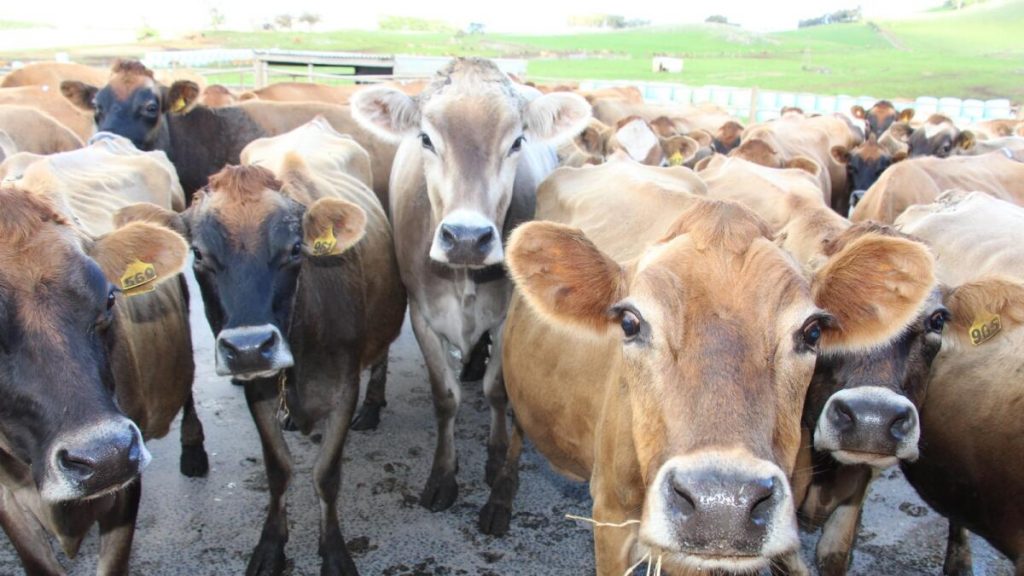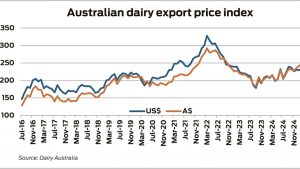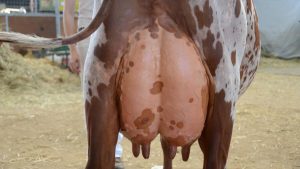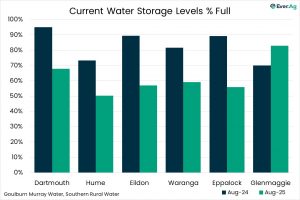
In its recently-released Q1 Global Dairy Quarterly report, the agribusiness banking specialist said Australian milk production reached 5.35 billion litres from July 2023 to January 2024, 2.5 per cent year-on-year higher.
The bank said summer rainfall had far exceeded expectations across much of Australia’s east coast, providing a good platform for livestock producers.
Report co-author, Rabobank senior dairy analyst Michael Harvey, said Australian dairy farmers were expected to enjoy a strong 2024.
“With milk prices remaining elevated, expectations are that new-season pricing from July 1 will be margin-supportive,” Mr Harvey said.
“And there is plenty of home-grown feed in storage, and purchased feed is affordable.”
Rabobank forecasts the Australian milk supply to finish the 2023-24 season (ending June 30) 2.6 per cent higher, with growth to continue into the new season in the range of three to four per cent for 2024-25.
Domestic market
Mr Harvey said the domestic Australian dairy market performance is stuttering, but is expected to improve in 2024.
“Australian household budgets remain strained, driving discretionary spending lower, which is flowing into the food basket,” he said.
“The financial health of Australian consumers is anticipated to improve as the year progresses, wages increase, tax cuts kick in and inflation normalises. And there are also potential interest rate cuts on the horizon.
“However, it is not all smooth sailing for consumers, with domestic economic growth for 2024 revised downward and unemployment revised upwards.”
Mr Harvey said disinflation is visible across Australian dairy grocery aisles. “Still, consumer prices are 20 per cent higher than before the inflation cycle, resulting in trading down across the main categories,” he said.
Dairy exports
Rabobank said Australian dairy exports had been under pressure in the first six months of the season.
“Volumes were 8.5 per cent lower than last year, with significant declines for milk, whole milk powder and butteroil,” Mr Harvey said.
“As milk supply grows into the new season, additional milk will be directed to manufacturing and potentially exports.
“Export competitiveness remains, but the gap between local and offshore farm gate milk prices has narrowed as milk prices in competitors’ regions increase on the back of improving commodity markets.”
Global outlook
Rabobank said global dairy prices have improved amid ongoing supply and demand challenges.
The quarterly report said despite the positive trend, dairy farmers worldwide continue to face margin challenges.
“Against a backdrop of buyers with adequate inventories and macroeconomic concerns, global dairy demand has shown sluggishness in recent months, and milk supply growth continues to struggle,” the report said.
“Key exporting regions experienced weaker year-on-year production in the second half of 2023, and we forecast lower output for the first two quarters of 2024 before a positive turn in the latter half of the year,” Mr Harvey said.
“After two consecutive quarters of weaker supply, a firmly bullish price response would typically have materialised,” he said.
“However, with global buyers’ current stock levels and broader economic worries offsetting lower milk volumes, the supply and demand balance is different this time.”
The bank expects the recent equilibrium between weaker supply and weaker demand will slowly shift throughout 2024, with prices moving to the upside as milk production continues to struggle but demand subtly improves.
“Slow, but steady, price increases among most dairy commodities will materialise in the coming months,” the report said.
“A return to 2022 price levels is unlikely, but gains versus 2023’s lows are probable.
“Coupled with lower expected feed costs, an improved margin outlook will eventually drive milk production growth in the ‘Big 7’ (the EU, US, New Zealand, Australia, Brazil, Argentina and Uruguay) by the second half of 2024.”
Mr Harvey said “it will likely not be a record price year by any measure” but farmers around the globe will welcome the return to profitability.
You can now read the most important #news on #eDairyNews #Whatsapp channels!!!
🇺🇸 eDairy News INGLÊS: https://whatsapp.com/channel/0029VaKsjzGDTkJyIN6hcP1K
























